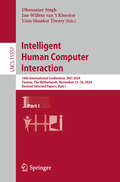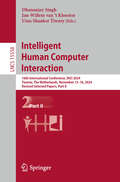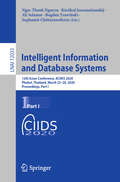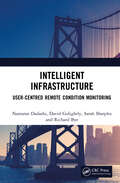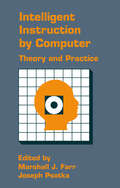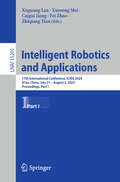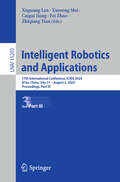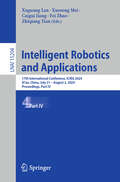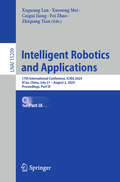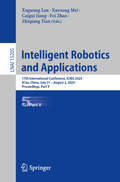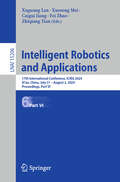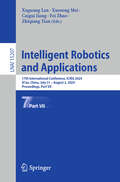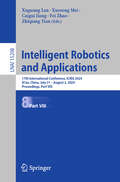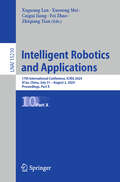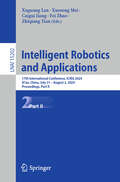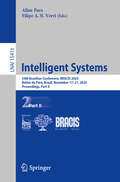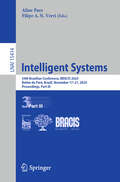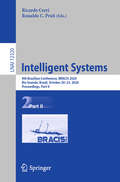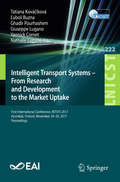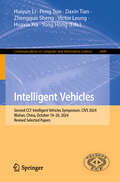- Table View
- List View
Intelligent Human Computer Interaction: 16th International Conference, IHCI 2024, Twente, The Netherlands, November 13–16, 2024, Revised Selected Papers, Part I (Lecture Notes in Computer Science #15557)
by Uma Shanker Tiwary Dhananjay Singh Jan-Willem van ’t KloosterThis volume LNCS 15557 constitutes the refereed proceedings of 16th International Conference on Intelligent Human Computer Interaction, IHCI 2024, held in Twente, The Netherlands, during November 13-16, 2024. The 37 full papers and 2 short papers were carefully reviewed and selected from 107 submissions. They were categorized under the topical sections as follows: Learning in healthcare and wellbeing Robots and conversation agents Physical world and Posters Human factors Algorithims and computer vision Human factors in cybersecurity
Intelligent Human Computer Interaction: 16th International Conference, IHCI 2024, Twente, The Netherlands, November 13–16, 2024, Revised Selected Papers, Part II (Lecture Notes in Computer Science #15558)
by Uma Shanker Tiwary Dhananjay Singh Jan-Willem van ’t KloosterThis volume LNCS 15557 constitutes the refereed proceedings of 16th International Conference on Intelligent Human Computer Interaction, IHCI 2024, held in Twente, The Netherlands, during November 13-16, 2024. The 37 full papers and 2 short papers were carefully reviewed and selected from 107 submissions. They were categorized under the topical sections as follows: HCI across domains Augmented & virtual reality Usability & UX Healthcare & clinical AI Centric HCI
Intelligent Information and Database Systems: 12th Asian Conference, ACIIDS 2020, Phuket, Thailand, March 23–26, 2020, Proceedings, Part I (Lecture Notes in Computer Science #12033)
by Ngoc Thanh Nguyen Ali Selamat Bogdan Trawiński Suphamit Chittayasothorn Kietikul JearanaitanakijThe two-volume set LNAI 12033 and 11034 constitutes the refereed proceedings of the 12th Asian Conference on Intelligent Information and Database Systems, ACIIDS 2020, held in Phuket, Thailand, in March 2020. The total of 105 full papers accepted for publication in these proceedings were carefully reviewed and selected from 285 submissions. The papers of the first volume are organized in the following topical sections: Knowledge Engineering and Semantic Web, Natural Language Processing, Decision Support and Control Systems, Computer Vision Techniques, Machine Learning and Data Mining, Deep Learning Models, Advanced Data Mining Techniques and Applications, Multiple Model Approach to Machine Learning. The papers of the second volume are divided into these topical sections: Application of Intelligent Methods to Constrained Problems, Automated Reasoning with Applications in Intelligent Systems, Current Trends in Arti cial Intelligence, Optimization, Learning,and Decision-Making in Bioinformatics and Bioengineering, Computer Vision and Intelligent Systems, Data Modelling and Processing for Industry 4.0, Intelligent Applications of Internet of Things and Data AnalysisTechnologies, Intelligent and Contextual Systems, Intelligent Systems and Algorithms in Information Sciences, Intelligent Supply Chains and e-Commerce, Privacy, Security and Trust in Arti cial Intelligence, Interactive Analysis of Image, Video and Motion Data in LifeSciences.
Intelligent Infrastructure: User-centred Remote Condition Monitoring
by Sarah Sharples Nastaran Dadashi David Golightly Richard ByeWith the development of sensor technology, wireless communications, big data, and machine learning, there is an increasing interest in technologies and solutions that assess and predict the state of equipment and assets within various industrial settings. These technologies aim to collect information from multiple sources about infrastructure asset status. Then, through current and historical data analysis, this configuration of technologies delivers intelligence on current and future asset status to a maintenance operator or manager to inform optimal maintenance decision-making. These technologies are known under different terms – remote condition monitoring, e-maintenance, prognostic systems, predictive maintenance, and smart or intelligent infrastructure. Despite the promise of remote condition monitoring and predictive technologies, there is a growing concern with such technologies because they can be difficult or impractical to use. Understanding and mitigating potential human factors issues could ensure that such vast investments are not wasted. This book considers, in depth, the challenges placed on users of current and future condition monitoring systems. Its primary focus is understanding the cognitive processes, including managing alarms, interpreting data, and collaborating with automation. The book describes a range of human factors methods that can be used to understand the current and future functioning of people and technology in an enhanced maintenance and asset monitoring context. The book also presents a framework for describing these issues systematically and presents the resulting design considerations to increase the effectiveness of individual operators and organisations as a whole.
Intelligent Instruction Computer: Theory And Practice
by Marshall J. Farr Joseph PsotkaThis text records the dramatic new prospects for computers in instruction in school, the workplace and high technology research facilities. If offers teachers and trainers a vision of how their professions will be fundamentally altered by these new systems and how their roles will be changed. The challenges and opportunities exposed by these developments in intelligent instruction by computer are many. Topics discussed include: apprenticeship and training in the workplace; automated tutoring in interactive environment; two approaches to simulation composition for training; and transfer, adaption, and use of intelligent tutoring technology.
Intelligent Robotics and Applications: 17th International Conference, ICIRA 2024, Xi'an, China, July 31 – August 2, 2024, Proceedings, Part I (Lecture Notes in Computer Science #15201)
by Xuguang Lan Xuesong Mei Caigui Jiang Fei Zhao Zhiqiang TianThe 10-volume set LNAI 15201-15210 constitutes the proceedings of the 17th International Conference on Intelligent Robotics and Applications, ICIRA 2024, which took place in Xi’an, China, during July 31–August 2, 2024. The 321 full papers included in these proceedings were carefully reviewed and selected from 489 submissions. They were organized in topical sections as follows: Part I: Innovative Design and Performance Evaluation of Robot Mechanisms. Part II: Robot Perception and Machine Learning; Cognitive Intelligence and Security Control for Multi-domain Unmanned Vehicle Systems. Part III: Emerging Techniques for Intelligent Robots in Unstructured Environment; Soft Actuators and Sensors; and Advanced Intelligent and Flexible Sensor Technologies for Robotics. Part IV: Optimization and Intelligent Control of Underactuated Robotic Systems; and Technology and application of modular robots. Part V: Advanced actuation and intelligent control in medical robotics: Advancements in Machine Vision for Enhancing Human-Robot Interaction; and Hybrid Decision-making and Control for Intelligent Robots. Part VI: Advances in Marine Robotics; Visual, Linguistic, Affective Agents: Hybrid-augmented Agents for Robotics; and Wearable Robots for Assistance, Augmentation and Rehabilitation of human movements. Part VII: Integrating World Models for Enhanced Robotic Autonomy; Advanced Sensing and Control Technologies for Intelligent Human-Robot Interaction; and Mini-Invasive Robotics for In-Situ Manipulation. Part VIII: Robot Skill Learning and Transfer; Human-Robot Dynamic System: Learning, Modelling and Control; AI-Driven Smart Industrial Systems; and Natural Interaction and Coordinated Collaboration of Robots in Dynamic Unstructured Environments. Part IX: Robotics in Cooperative Manipulation, MultiSensor Fusion, and Multi-Robot Systems; Human-machine Co-adaptive Interface; Brain inspired intelligence for robotics; Planning, control and application of bionic novel concept robots; and Robust Perception for Safe Driving. Part X: AI Robot Technology for Healthcare as a Service; Computational Neuroscience and Cognitive Models for Adaptive Human-Robot Interactions; Dynamics and Perception of Human-Robot Hybrid Systems; and Robotics for Rehabilitation: Innovations, Challenges, and Future Directions.
Intelligent Robotics and Applications: 17th International Conference, ICIRA 2024, Xi'an, China, July 31 – August 2, 2024, Proceedings, Part III (Lecture Notes in Computer Science #15203)
by Xuguang Lan Xuesong Mei Caigui Jiang Fei Zhao Zhiqiang TianThe 10-volume set LNAI 15201-15210 constitutes the proceedings of the 17th International Conference on Intelligent Robotics and Applications, ICIRA 2024, which took place in Xi’an, China, during July 31–August 2, 2024. The 321 full papers included in these proceedings were carefully reviewed and selected from 489 submissions. They were organized in topical sections as follows: Part I: Innovative Design and Performance Evaluation of Robot Mechanisms. Part II: Robot Perception and Machine Learning; Cognitive Intelligence and Security Control for Multi-domain Unmanned Vehicle Systems. Part III: Emerging Techniques for Intelligent Robots in Unstructured Environment; Soft Actuators and Sensors; and Advanced Intelligent and Flexible Sensor Technologies for Robotics. Part IV: Optimization and Intelligent Control of Underactuated Robotic Systems; and Technology and application of modular robots. Part V: Advanced actuation and intelligent control in medical robotics: Advancements in Machine Vision for Enhancing Human-Robot Interaction; and Hybrid Decision-making and Control for Intelligent Robots. Part VI: Advances in Marine Robotics; Visual, Linguistic, Affective Agents: Hybrid-augmented Agents for Robotics; and Wearable Robots for Assistance, Augmentation and Rehabilitation of human movements. Part VII: Integrating World Models for Enhanced Robotic Autonomy; Advanced Sensing and Control Technologies for Intelligent Human-Robot Interaction; and Mini-Invasive Robotics for In-Situ Manipulation. Part VIII: Robot Skill Learning and Transfer; Human-Robot Dynamic System: Learning, Modelling and Control; AI-Driven Smart Industrial Systems; and Natural Interaction and Coordinated Collaboration of Robots in Dynamic Unstructured Environments. Part IX: Robotics in Cooperative Manipulation, MultiSensor Fusion, and Multi-Robot Systems; Human-machine Co-adaptive Interface; Brain inspired intelligence for robotics; Planning, control and application of bionic novel concept robots; and Robust Perception for Safe Driving. Part X: AI Robot Technology for Healthcare as a Service; Computational Neuroscience and Cognitive Models for Adaptive Human-Robot Interactions; Dynamics and Perception of Human-Robot Hybrid Systems; and Robotics for Rehabilitation: Innovations, Challenges, and Future Directions.
Intelligent Robotics and Applications: 17th International Conference, ICIRA 2024, Xi'an, China, July 31 – August 2, 2024, Proceedings, Part IV (Lecture Notes in Computer Science #15204)
by Xuguang Lan Xuesong Mei Caigui Jiang Fei Zhao Zhiqiang TianThe 10-volume set LNAI 15201-15210 constitutes the proceedings of the 17th International Conference on Intelligent Robotics and Applications, ICIRA 2024, which took place in Xi’an, China, during July 31–August 2, 2024. The 321 full papers included in these proceedings were carefully reviewed and selected from 489 submissions. They were organized in topical sections as follows: Part I: Innovative Design and Performance Evaluation of Robot Mechanisms. Part II: Robot Perception and Machine Learning; Cognitive Intelligence and Security Control for Multi-domain Unmanned Vehicle Systems. Part III: Emerging Techniques for Intelligent Robots in Unstructured Environment; Soft Actuators and Sensors; and Advanced Intelligent and Flexible Sensor Technologies for Robotics. Part IV: Optimization and Intelligent Control of Underactuated Robotic Systems; and Technology and application of modular robots. Part V: Advanced actuation and intelligent control in medical robotics: Advancements in Machine Vision for Enhancing Human-Robot Interaction; and Hybrid Decision-making and Control for Intelligent Robots. Part VI: Advances in Marine Robotics; Visual, Linguistic, Affective Agents: Hybrid-augmented Agents for Robotics; and Wearable Robots for Assistance, Augmentation and Rehabilitation of human movements. Part VII: Integrating World Models for Enhanced Robotic Autonomy; Advanced Sensing and Control Technologies for Intelligent Human-Robot Interaction; and Mini-Invasive Robotics for In-Situ Manipulation. Part VIII: Robot Skill Learning and Transfer; Human-Robot Dynamic System: Learning, Modelling and Control; AI-Driven Smart Industrial Systems; and Natural Interaction and Coordinated Collaboration of Robots in Dynamic Unstructured Environments. Part IX: Robotics in Cooperative Manipulation, MultiSensor Fusion, and Multi-Robot Systems; Human-machine Co-adaptive Interface; Brain inspired intelligence for robotics; Planning, control and application of bionic novel concept robots; and Robust Perception for Safe Driving. Part X: AI Robot Technology for Healthcare as a Service; Computational Neuroscience and Cognitive Models for Adaptive Human-Robot Interactions; Dynamics and Perception of Human-Robot Hybrid Systems; and Robotics for Rehabilitation: Innovations, Challenges, and Future Directions.
Intelligent Robotics and Applications: 17th International Conference, ICIRA 2024, Xi'an, China, July 31 – August 2, 2024, Proceedings, Part IX (Lecture Notes in Computer Science #15209)
by Xuguang Lan Xuesong Mei Caigui Jiang Fei Zhao Zhiqiang TianThe 10-volume set LNAI 15201-15210 constitutes the proceedings of the 17th International Conference on Intelligent Robotics and Applications, ICIRA 2024, which took place in Xi’an, China, during July 31–August 2, 2024. The 321 full papers included in these proceedings were carefully reviewed and selected from 489 submissions. They were organized in topical sections as follows: Part I: Innovative Design and Performance Evaluation of Robot Mechanisms. Part II: Robot Perception and Machine Learning; Cognitive Intelligence and Security Control for Multi-domain Unmanned Vehicle Systems. Part III: Emerging Techniques for Intelligent Robots in Unstructured Environment; Soft Actuators and Sensors; and Advanced Intelligent and Flexible Sensor Technologies for Robotics. Part IV: Optimization and Intelligent Control of Underactuated Robotic Systems; and Technology and application of modular robots. Part V: Advanced actuation and intelligent control in medical robotics: Advancements in Machine Vision for Enhancing Human-Robot Interaction; and Hybrid Decision-making and Control for Intelligent Robots. Part VI: Advances in Marine Robotics; Visual, Linguistic, Affective Agents: Hybrid-augmented Agents for Robotics; and Wearable Robots for Assistance, Augmentation and Rehabilitation of human movements. Part VII: Integrating World Models for Enhanced Robotic Autonomy; Advanced Sensing and Control Technologies for Intelligent Human-Robot Interaction; and Mini-Invasive Robotics for In-Situ Manipulation. Part VIII: Robot Skill Learning and Transfer; Human-Robot Dynamic System: Learning, Modelling and Control; AI-Driven Smart Industrial Systems; and Natural Interaction and Coordinated Collaboration of Robots in Dynamic Unstructured Environments. Part IX: Robotics in Cooperative Manipulation, MultiSensor Fusion, and Multi-Robot Systems; Human-machine Co-adaptive Interface; Brain inspired intelligence for robotics; Planning, control and application of bionic novel concept robots; and Robust Perception for Safe Driving. Part X: AI Robot Technology for Healthcare as a Service; Computational Neuroscience and Cognitive Models for Adaptive Human-Robot Interactions; Dynamics and Perception of Human-Robot Hybrid Systems; and Robotics for Rehabilitation: Innovations, Challenges, and Future Directions.
Intelligent Robotics and Applications: 17th International Conference, ICIRA 2024, Xi'an, China, July 31 – August 2, 2024, Proceedings, Part V (Lecture Notes in Computer Science #15205)
by Xuguang Lan Xuesong Mei Caigui Jiang Fei Zhao Zhiqiang TianThe 10-volume set LNAI 15201-15210 constitutes the proceedings of the 17th International Conference on Intelligent Robotics and Applications, ICIRA 2024, which took place in Xi’an, China, during July 31–August 2, 2024. The 321 full papers included in these proceedings were carefully reviewed and selected from 489 submissions. They were organized in topical sections as follows: Part I: Innovative Design and Performance Evaluation of Robot Mechanisms. Part II: Robot Perception and Machine Learning; Cognitive Intelligence and Security Control for Multi-domain Unmanned Vehicle Systems. Part III: Emerging Techniques for Intelligent Robots in Unstructured Environment; Soft Actuators and Sensors; and Advanced Intelligent and Flexible Sensor Technologies for Robotics. Part IV: Optimization and Intelligent Control of Underactuated Robotic Systems; and Technology and application of modular robots. Part V: Advanced actuation and intelligent control in medical robotics: Advancements in Machine Vision for Enhancing Human-Robot Interaction; and Hybrid Decision-making and Control for Intelligent Robots. Part VI: Advances in Marine Robotics; Visual, Linguistic, Affective Agents: Hybrid-augmented Agents for Robotics; and Wearable Robots for Assistance, Augmentation and Rehabilitation of human movements. Part VII: Integrating World Models for Enhanced Robotic Autonomy; Advanced Sensing and Control Technologies for Intelligent Human-Robot Interaction; and Mini-Invasive Robotics for In-Situ Manipulation. Part VIII: Robot Skill Learning and Transfer; Human-Robot Dynamic System: Learning, Modelling and Control; AI-Driven Smart Industrial Systems; and Natural Interaction and Coordinated Collaboration of Robots in Dynamic Unstructured Environments. Part IX: Robotics in Cooperative Manipulation, MultiSensor Fusion, and Multi-Robot Systems; Human-machine Co-adaptive Interface; Brain inspired intelligence for robotics; Planning, control and application of bionic novel concept robots; and Robust Perception for Safe Driving. Part X: AI Robot Technology for Healthcare as a Service; Computational Neuroscience and Cognitive Models for Adaptive Human-Robot Interactions; Dynamics and Perception of Human-Robot Hybrid Systems; and Robotics for Rehabilitation: Innovations, Challenges, and Future Directions.
Intelligent Robotics and Applications: 17th International Conference, ICIRA 2024, Xi'an, China, July 31 – August 2, 2024, Proceedings, Part VI (Lecture Notes in Computer Science #15206)
by Xuguang Lan Xuesong Mei Caigui Jiang Fei Zhao Zhiqiang TianThe 10-volume set LNAI 15201-15210 constitutes the proceedings of the 17th International Conference on Intelligent Robotics and Applications, ICIRA 2024, which took place in Xi’an, China, during July 31–August 2, 2024. The 321 full papers included in these proceedings were carefully reviewed and selected from 489 submissions. They were organized in topical sections as follows: Part I: Innovative Design and Performance Evaluation of Robot Mechanisms. Part II: Robot Perception and Machine Learning; Cognitive Intelligence and Security Control for Multi-domain Unmanned Vehicle Systems. Part III: Emerging Techniques for Intelligent Robots in Unstructured Environment; Soft Actuators and Sensors; and Advanced Intelligent and Flexible Sensor Technologies for Robotics. Part IV: Optimization and Intelligent Control of Underactuated Robotic Systems; and Technology and application of modular robots. Part V: Advanced actuation and intelligent control in medical robotics: Advancements in Machine Vision for Enhancing Human-Robot Interaction; and Hybrid Decision-making and Control for Intelligent Robots. Part VI: Advances in Marine Robotics; Visual, Linguistic, Affective Agents: Hybrid-augmented Agents for Robotics; and Wearable Robots for Assistance, Augmentation and Rehabilitation of human movements. Part VII: Integrating World Models for Enhanced Robotic Autonomy; Advanced Sensing and Control Technologies for Intelligent Human-Robot Interaction; and Mini-Invasive Robotics for In-Situ Manipulation. Part VIII: Robot Skill Learning and Transfer; Human-Robot Dynamic System: Learning, Modelling and Control; AI-Driven Smart Industrial Systems; and Natural Interaction and Coordinated Collaboration of Robots in Dynamic Unstructured Environments. Part IX: Robotics in Cooperative Manipulation, MultiSensor Fusion, and Multi-Robot Systems; Human-machine Co-adaptive Interface; Brain inspired intelligence for robotics; Planning, control and application of bionic novel concept robots; and Robust Perception for Safe Driving. Part X: AI Robot Technology for Healthcare as a Service; Computational Neuroscience and Cognitive Models for Adaptive Human-Robot Interactions; Dynamics and Perception of Human-Robot Hybrid Systems; and Robotics for Rehabilitation: Innovations, Challenges, and Future Directions.
Intelligent Robotics and Applications: 17th International Conference, ICIRA 2024, Xi'an, China, July 31 – August 2, 2024, Proceedings, Part VII (Lecture Notes in Computer Science #15207)
by Xuguang Lan Xuesong Mei Caigui Jiang Fei Zhao Zhiqiang TianThe 10-volume set LNAI 15201-15210 constitutes the proceedings of the 17th International Conference on Intelligent Robotics and Applications, ICIRA 2024, which took place in Xi’an, China, during July 31–August 2, 2024. The 321 full papers included in these proceedings were carefully reviewed and selected from 489 submissions. They were organized in topical sections as follows: Part I: Innovative Design and Performance Evaluation of Robot Mechanisms. Part II: Robot Perception and Machine Learning; Cognitive Intelligence and Security Control for Multi-domain Unmanned Vehicle Systems. Part III: Emerging Techniques for Intelligent Robots in Unstructured Environment; Soft Actuators and Sensors; and Advanced Intelligent and Flexible Sensor Technologies for Robotics. Part IV: Optimization and Intelligent Control of Underactuated Robotic Systems; and Technology and application of modular robots. Part V: Advanced actuation and intelligent control in medical robotics: Advancements in Machine Vision for Enhancing Human-Robot Interaction; and Hybrid Decision-making and Control for Intelligent Robots. Part VI: Advances in Marine Robotics; Visual, Linguistic, Affective Agents: Hybrid-augmented Agents for Robotics; and Wearable Robots for Assistance, Augmentation and Rehabilitation of human movements. Part VII: Integrating World Models for Enhanced Robotic Autonomy; Advanced Sensing and Control Technologies for Intelligent Human-Robot Interaction; and Mini-Invasive Robotics for In-Situ Manipulation. Part VIII: Robot Skill Learning and Transfer; Human-Robot Dynamic System: Learning, Modelling and Control; AI-Driven Smart Industrial Systems; and Natural Interaction and Coordinated Collaboration of Robots in Dynamic Unstructured Environments. Part IX: Robotics in Cooperative Manipulation, MultiSensor Fusion, and Multi-Robot Systems; Human-machine Co-adaptive Interface; Brain inspired intelligence for robotics; Planning, control and application of bionic novel concept robots; and Robust Perception for Safe Driving. Part X: AI Robot Technology for Healthcare as a Service; Computational Neuroscience and Cognitive Models for Adaptive Human-Robot Interactions; Dynamics and Perception of Human-Robot Hybrid Systems; and Robotics for Rehabilitation: Innovations, Challenges, and Future Directions.
Intelligent Robotics and Applications: 17th International Conference, ICIRA 2024, Xi'an, China, July 31 – August 2, 2024, Proceedings, Part VIII (Lecture Notes in Computer Science #15208)
by Xuguang Lan Xuesong Mei Caigui Jiang Fei Zhao Zhiqiang TianThe 10-volume set LNAI 15201-15210 constitutes the proceedings of the 17th International Conference on Intelligent Robotics and Applications, ICIRA 2024, which took place in Xi’an, China, during July 31–August 2, 2024. The 321 full papers included in these proceedings were carefully reviewed and selected from 489 submissions. They were organized in topical sections as follows: Part I: Innovative Design and Performance Evaluation of Robot Mechanisms. Part II: Robot Perception and Machine Learning; Cognitive Intelligence and Security Control for Multi-domain Unmanned Vehicle Systems. Part III: Emerging Techniques for Intelligent Robots in Unstructured Environment; Soft Actuators and Sensors; and Advanced Intelligent and Flexible Sensor Technologies for Robotics. Part IV: Optimization and Intelligent Control of Underactuated Robotic Systems; and Technology and application of modular robots. Part V: Advanced actuation and intelligent control in medical robotics: Advancements in Machine Vision for Enhancing Human-Robot Interaction; and Hybrid Decision-making and Control for Intelligent Robots. Part VI: Advances in Marine Robotics; Visual, Linguistic, Affective Agents: Hybrid-augmented Agents for Robotics; and Wearable Robots for Assistance, Augmentation and Rehabilitation of human movements. Part VII: Integrating World Models for Enhanced Robotic Autonomy; Advanced Sensing and Control Technologies for Intelligent Human-Robot Interaction; and Mini-Invasive Robotics for In-Situ Manipulation. Part VIII: Robot Skill Learning and Transfer; Human-Robot Dynamic System: Learning, Modelling and Control; AI-Driven Smart Industrial Systems; and Natural Interaction and Coordinated Collaboration of Robots in Dynamic Unstructured Environments. Part IX: Robotics in Cooperative Manipulation, MultiSensor Fusion, and Multi-Robot Systems; Human-machine Co-adaptive Interface; Brain inspired intelligence for robotics; Planning, control and application of bionic novel concept robots; and Robust Perception for Safe Driving. Part X: AI Robot Technology for Healthcare as a Service; Computational Neuroscience and Cognitive Models for Adaptive Human-Robot Interactions; Dynamics and Perception of Human-Robot Hybrid Systems; and Robotics for Rehabilitation: Innovations, Challenges, and Future Directions.
Intelligent Robotics and Applications: 17th International Conference, ICIRA 2024, Xi'an, China, July 31–August 2, 2024, Proceedings, Part X (Lecture Notes in Computer Science #15210)
by Xuguang Lan Xuesong Mei Caigui Jiang Fei Zhao Zhiqiang TianThe 10-volume set LNAI 15201-15210 constitutes the proceedings of the 17th International Conference on Intelligent Robotics and Applications, ICIRA 2024, which took place in Xi’an, China, during July 31–August 2, 2024. The 321 full papers included in these proceedings were carefully reviewed and selected from 489 submissions. They were organized in topical sections as follows: Part I: Innovative Design and Performance Evaluation of Robot Mechanisms. Part II: Robot Perception and Machine Learning; Cognitive Intelligence and Security Control for Multi-domain Unmanned Vehicle Systems. Part III: Emerging Techniques for Intelligent Robots in Unstructured Environment; Soft Actuators and Sensors; and Advanced Intelligent and Flexible Sensor Technologies for Robotics. Part IV: Optimization and Intelligent Control of Underactuated Robotic Systems; and Technology and application of modular robots. Part V: Advanced actuation and intelligent control in medical robotics: Advancements in Machine Vision for Enhancing Human-Robot Interaction; and Hybrid Decision-making and Control for Intelligent Robots. Part VI: Advances in Marine Robotics; Visual, Linguistic, Affective Agents: Hybrid-augmented Agents for Robotics; and Wearable Robots for Assistance, Augmentation and Rehabilitation of human movements. Part VII: Integrating World Models for Enhanced Robotic Autonomy; Advanced Sensing and Control Technologies for Intelligent Human-Robot Interaction; and Mini-Invasive Robotics for In-Situ Manipulation. Part VIII: Robot Skill Learning and Transfer; Human-Robot Dynamic System: Learning, Modelling and Control; AI-Driven Smart Industrial Systems; and Natural Interaction and Coordinated Collaboration of Robots in Dynamic Unstructured Environments. Part IX: Robotics in Cooperative Manipulation, MultiSensor Fusion, and Multi-Robot Systems; Human-machine Co-adaptive Interface; Brain inspired intelligence for robotics; Planning, control and application of bionic novel concept robots; and Robust Perception for Safe Driving. Part X: AI Robot Technology for Healthcare as a Service; Computational Neuroscience and Cognitive Models for Adaptive Human-Robot Interactions; Dynamics and Perception of Human-Robot Hybrid Systems; and Robotics for Rehabilitation: Innovations, Challenges, and Future Directions.
Intelligent Robotics and Applications: 17th International Conference, ICIRA 2024, Xi’an, China, July 31 – August 2, 2024, Proceedings, Part II (Lecture Notes in Computer Science #15202)
by Xuguang Lan Xuesong Mei Caigui Jiang Fei Zhao Zhiqiang TianThe 10-volume set LNAI 15201-15210 constitutes the proceedings of the 17th International Conference on Intelligent Robotics and Applications, ICIRA 2024, which took place in Xi’an, China, during July 31–August 2, 2024. The 321 full papers included in these proceedings were carefully reviewed and selected from 489 submissions. They were organized in topical sections as follows: Part I: Innovative Design and Performance Evaluation of Robot Mechanisms. Part II: Robot Perception and Machine Learning; Cognitive Intelligence and Security Control for Multi-domain Unmanned Vehicle Systems. Part III: Emerging Techniques for Intelligent Robots in Unstructured Environment; Soft Actuators and Sensors; and Advanced Intelligent and Flexible Sensor Technologies for Robotics. Part IV: Optimization and Intelligent Control of Underactuated Robotic Systems; and Technology and application of modular robots. Part V: Advanced actuation and intelligent control in medical robotics: Advancements in Machine Vision for Enhancing Human-Robot Interaction; and Hybrid Decision-making and Control for Intelligent Robots. Part VI: Advances in Marine Robotics; Visual, Linguistic, Affective Agents: Hybrid-augmented Agents for Robotics; and Wearable Robots for Assistance, Augmentation and Rehabilitation of human movements. Part VII: Integrating World Models for Enhanced Robotic Autonomy; Advanced Sensing and Control Technologies for Intelligent Human-Robot Interaction; and Mini-Invasive Robotics for In-Situ Manipulation. Part VIII: Robot Skill Learning and Transfer; Human-Robot Dynamic System: Learning, Modelling and Control; AI-Driven Smart Industrial Systems; and Natural Interaction and Coordinated Collaboration of Robots in Dynamic Unstructured Environments. Part IX: Robotics in Cooperative Manipulation, MultiSensor Fusion, and Multi-Robot Systems; Human-machine Co-adaptive Interface; Brain inspired intelligence for robotics; Planning, control and application of bionic novel concept robots; and Robust Perception for Safe Driving. Part X: AI Robot Technology for Healthcare as a Service; Computational Neuroscience and Cognitive Models for Adaptive Human-Robot Interactions; Dynamics and Perception of Human-Robot Hybrid Systems; and Robotics for Rehabilitation: Innovations, Challenges, and Future Directions.
Intelligent Systems and Industrial Internet of Things for Sustainable Development (Digital Technologies and Innovative Solutions for Sustainable Development)
by C. Kishor Kumar Reddy, P. R. Anisha, Marlia Mohd Hanafiah, Srinath Doss and Kari LippertThe book studies emerging and sustaining technologies for applications of Industry 5.0 to develop technological solutions to address numerous real-life challenges to solve sustainable development-related issues. It identifies limitations, pitfalls, and open research questions in industry 5.0, discusses real-time problems, and challenges with equivalent solutions with a focus on sustainable growth to develop, humanization and environmentally friendly intelligent system applications. It analyses applications enabled by Industry 5.0 such as healthcare, supply chain, smart framing, remote sensing, production in manufacturing, and cloud manufacturing. It also includes the difficulties and problems posed by the organization between robots and humans on the assembly line to maintain sustainability. Addresses key challenges in implementing intelligent systems in IoT-based applications, including issues ranging from cost and energy efficiency to availability and quality of service Explores the technologies to allow human-machine association and its impact on consumption and sustainability Provides sustainable solutions to emerging industrial problems, especially in healthcare, manufacturing, remote sensing, environmental engineering Examines need for data pre-processing, classification & prediction, Cluster Analysis, Mining Multimedia, Text, and Web Data, Advanced machine learning techniques for scientific programming in Industry Presents success stories in the form of case studies of IIoT, IIoRT, Big Data, Intelligent Systems, Deep Learning in Industry 5.0 era The text is for postgraduate students, professionals, and academic researchers working in the fields of computer science and information technology, especially for professionals and researchers interested in the technological side of sustainable development.
Intelligent Systems: 34th Brazilian Conference, BRACIS 2024, Belém do Pará, Brazil, November 17–21, 2024, Proceedings, Part II (Lecture Notes in Computer Science #15413)
by Aline Paes Filipe A. N. VerriThe four-volume set LNAI 15412-15415 constitutes the refereed proceedings of the 34th Brazilian Conference on Intelligent Systems, BRACIS 2024, held in Belém do Pará, Brazil, during November 17–21, 2024. The 116 full papers presented here were carefully reviewed and selected from 285 submissions. They were organized in three key tracks: 70 articles in the main track, showcasing cutting-edge AI methods and solid results; 10 articles in the AI for Social Good track, featuring innovative applications of AI for societal benefit using established methodologies; and 36 articles in other AI applications, presenting novel applications using established AI methods, naturally considering the ethical aspects of the application.
Intelligent Systems: 34th Brazilian Conference, BRACIS 2024, Belém do Pará, Brazil, November 17–21, 2024, Proceedings, Part III (Lecture Notes in Computer Science #15414)
by Aline Paes Filipe A. N. VerriThe four-volume set LNAI 15412-15415 constitutes the refereed proceedings of the 34th Brazilian Conference on Intelligent Systems, BRACIS 2024, held in Belém do Pará, Brazil, during November 17–21, 2024. The 116 full papers presented here were carefully reviewed and selected from 285 submissions. They were organized in three key tracks: 70 articles in the main track, showcasing cutting-edge AI methods and solid results; 10 articles in the AI for Social Good track, featuring innovative applications of AI for societal benefit using established methodologies; and 36 articles in other AI applications, presenting novel applications using established AI methods, naturally considering the ethical aspects of the application.
Intelligent Systems: 9th Brazilian Conference, BRACIS 2020, Rio Grande, Brazil, October 20–23, 2020, Proceedings, Part II (Lecture Notes in Computer Science #12320)
by Ronaldo C. Prati Ricardo CerriThe two-volume set LNAI 12319 and 12320 constitutes the proceedings of the 9th Brazilian Conference on Intelligent Systems, BRACIS 2020, held in Rio Grande, Brazil, in October 2020. The total of 90 papers presented in these two volumes was carefully reviewed and selected from 228 submissions. The contributions are organized in the following topical section: Part I: Evolutionary computation, metaheuristics, constrains and search, combinatorial and numerical optimization; neural networks, deep learning and computer vision; and text mining and natural language processing. Part II: Agent and multi-agent systems, planning and reinforcement learning; knowledge representation, logic and fuzzy systems; machine learning and data mining; and multidisciplinary artificial and computational intelligence and applications.Due to the Corona pandemic BRACIS 2020 was held as a virtual event.
Intelligent Technologies for Interactive Entertainment: 14th EAI International Conference, INTETAIN 2023, Lucca, Italy, November 27, 2023, Proceedings (Lecture Notes of the Institute for Computer Sciences, Social Informatics and Telecommunications Engineering #560)
by Martin Clayton Mauro Passacantando Marcello SanguinetiThis book constitutes the refereed proceedings of the 14th International Conference on Intelligent Technologies for Interactive Entertainment, INTETAIN 2023 which was held in Lucca, Italy, during November 27, 2023.The 15 full papers presented in this book were selected from 56 submissions. They present novel and innovative work in areas of methods (machine learning, movement), computer-based systems (architectures, software, algorithms), and devices (digital cameras, smartphones). The papers are grouped in sessions of thematic issues on Games and Game-Based learning; Motion Capture; Sports and Competitions; and Interfaces and Applications.
Intelligent Transport System in Smart Cities: Aspects and Challenges of Vehicular Networks and Cloud (Urban Computing)
by Rodolfo I. Meneguette Robson E. De Grande Antonio A. F. LoureiroThis book presents a timely description of currently used and proposed technologies that involve the intelligent transport system to assist the manager of large cities. Therefore, it describes all concepts and technologies that address the challenges, bringing up a top-down approach, which begins from the vehicular network and central infrastructure to a distributed structure.For scientists and researchers, this book will bring together the state-of-the-art of the main techniques that involve intelligent transport systems to assist the manager of big cities.For practitioners and professionals, this book will describe techniques which can be put into practice and use to aid the development of new applications and services. Concerning postgraduate students, this book will provide highlights of main concerns and concepts and explain techniques that can assist students to identify challenges that they can explore, contribute to, and advance the current status of technology.
Intelligent Transport Systems – From Research and Development to the Market Uptake: First International Conference, INTSYS 2017, Hyvinkää, Finland, November 29-30, 2017, Proceedings (Lecture Notes of the Institute for Computer Sciences, Social Informatics and Telecommunications Engineering #222)
by Giuseppe Lugano Tatiana Kováčiková Ľuboš Buzna Ghadir Pourhashem Yannick Cornet Nathalie LuganoThis book constitutes the proceedings of the First International Conference on Intelligent Transport Systems, INTSYS 2107, which was held in Helsinki, Finland, in November 2017. The 30 revised full papers were selected from 47 submissions and are organized in 6 thematic sessions on planning and sustainable transport and smart cities, intelligent rail transport systems, transport modelling and simulation & big data application, ITS safety and security, cooperative ITS and autonomous driving, and intelligent traffic management.
Intelligent Vehicles: Second CCF Intelligent Vehicles Symposium, CIVS 2024, Wuhan, China, October 19–20, 2024, Revised Selected Papers (Communications in Computer and Information Science #2449)
by Zhengguo Sheng Daxin Tian Victor Leung Huiyun Li Peng Sun Huaxia Xia Yong HongThis book constitutes the refereed proceedings of the Second CCF Intelligent Vehicles Symposium on Intelligent Vehicles, CCF CIVS 2024, held in Wuhan, China, during October 19–20, 2024. The 31 full papers included in this book were carefully reviewed and selected from 60 submissions. The papers contained in these proceedings address challenging issues in autonomous driving, lidar, radar, camera, LLM, battery, motor, electronic control, charging technology, sensing, location, HD Maps, navigation, prediction, planning, control, security, vehicular networking and communication, as well as the fundamentals and applications of computing.
Intense Group Behavior and Brand Negativity: Comparing Rivalry in Politics, Religion, and Sport
by Cody T. HavardIn previous books, the author has investigated rivalry in the context of sport and non-sport settings. This book investigates how rivalry and group member behavior manifests in the setting of politics, religion, and sport, three settings of intense group member bias. Building on the author’s Hierarchy of Out-group Derogation (HOD) and Out-group Derogation Spectrum (ODS), it discusses the potential of common interests to drive out-group cooperation. The work ends with a call for future research to better understand how to decrease out-group derogation and negativity. Incorporating research from marketing, psychology, political science, and sociology, this book offers researchers in several fields a new understanding of how setting and group membership influences the ways people view and behave toward out-groups.
Intensive Culture: Social Theory, Religion & Contemporary Capitalism (Published in association with Theory, Culture & Society)
by Scott M LashContemporary culture, today's capitalism - our global information society - is ever expanding, is ever more extensive. And yet we seem to be experiencing a parallel phenomenon which can only be characterised as intensive. This thought provoking, innovative book is dedicated to the study of such intensive culture. Whilst extensive culture is a culture of the same: a culture of fixed equivalence; intensive culture is a culture of difference, of in-equivalence - the singular. Intensities generate what we encounter. They are virtuals or possibilities, always in process and always in movement. We thus live in a culture that is both extensive and intensive. Indeed the more globally stretched and extensive social relations become the more they simultaneously seem to take on this intensity. Ours is a relational world where each intensity ? whether human, technological or biological ? provides a distinct, specific window onto the whole. Lash tracks the emergence and pervasion of this intensive culture in society, religion, philosophy, language, communications, politics and the neo-liberal economy itself. In so doing he redefines the work of Leibniz, Benjamin, Simmel, and Durkheim and inititates the reader into the ontological structures of our contemporary social relations. In the pursuit of intensive culture the reader is taken on an excursion from Karl Marx's Capital to the 'information theology' in the science fiction of Philip K. Dick. Diverse, engaging and rich in detail the resulting book will be of interest to all those studying social and cultural theory, sociology, media and communication and cultural studies
